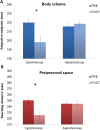The sense of agency shapes body schema and peripersonal space
- PMID: 30218103
- PMCID: PMC6138644
- DOI: 10.1038/s41598-018-32238-z
The sense of agency shapes body schema and peripersonal space
Abstract
Body schema, a sensorimotor representation of the body used for planning and executing movements, is plastic because it extends by using a tool to reach far objects. Modifications of peripersonal space, i.e., a functional representation of reach space, usually co-occur with body schema changes. Here, we hypothesized that such plastic changes depend on the experience of controlling the course of events in space trough one's own actions, i.e., the sense of agency. In two experiments, body schema and peripersonal space were assessed before and after the participants' sense of agency over a virtual hand was manipulated. Body schema and peripersonal space enlarged or contracted depending on whether the virtual hand was presented in far space, or closer to the participants' body than the real hand. These findings suggest that body schema and peripersonal space are affected by the dynamic mapping between intentional body movements and expected consequences in space.
Conflict of interest statement
The authors declare no competing interests.
Figures






References
Publication types
MeSH terms
LinkOut - more resources
Full Text Sources
Other Literature Sources

